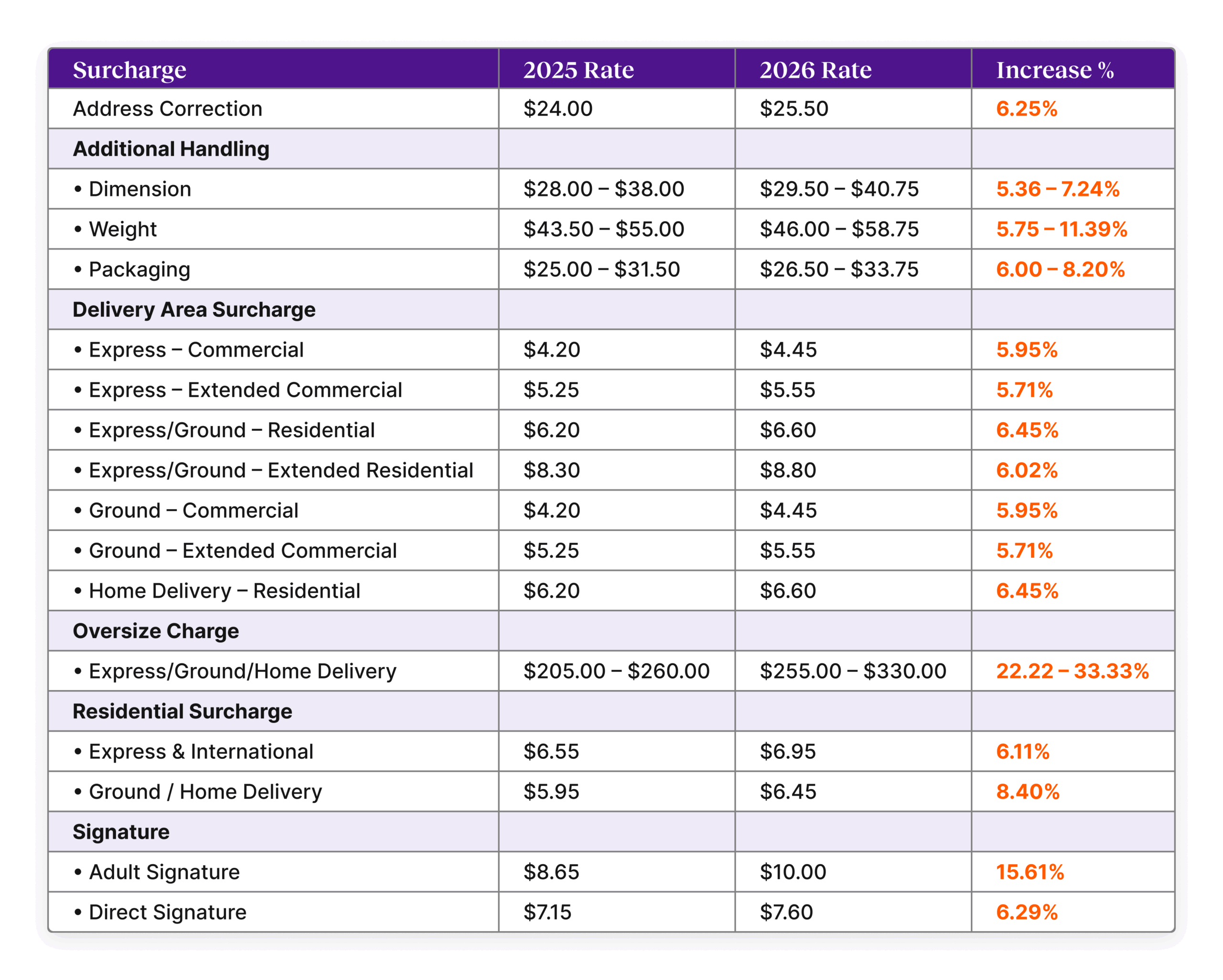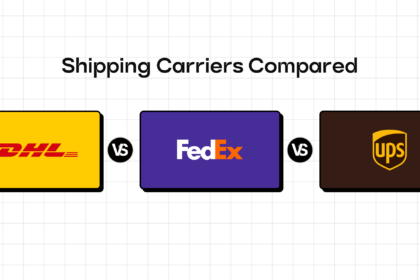Introduction To The Rate Increase By Fedex And Ups In 2024
Every January, shippers brace themselves for the annual General Rate Increase (GRI) announcements from FedEx and UPS. These changes often reshape logistics budgets for the year ahead, and 2026 is no exception.
FedEx has already confirmed an average 5.9% increase across most U.S. package, export, and import services effective January 5, 2026, along with notable changes to surcharges and dimensional rules. UPS, meanwhile, has yet to release its 2026 increase, though based on historical patterns it’s expected soon and likely to mirror FedEx’s move.
Why Are FedEx and UPS Rates Increasing Year-Over-Year?
FedEx and UPS have long followed a pattern of annual hikes, typically in the 4.9–6.9% range. On the surface, these increases reflect inflation and rising operational costs such as labor, fuel, and technology investments. But the story runs deeper.
Parcel carriers are grappling with the complexity of residential deliveries, longer last-mile routes, and diverse package profiles. They’re also under pressure to improve margins, which often leads to targeting specific areas of their network where demand is high or costs are harder to control. In practice, that means the headline figure—5.9% in 2026 rarely tells the full story. The real impact depends on a shipper’s package sizes, service levels, and the zones they ship into.
For UPS, while we don’t yet have the official announcement, it’s safe to assume their increase will land in a similar range, just as it has for the last several years. When UPS publishes the details, we’ll update this blog with a full comparison.
FedEx Rate Increase Details for 2026

Below is a detailed view of what the FedEx 2026 GRI entails and why the “5.9% average” headline conceals more complexity.
Base Rate & Freight
The standard list rates for U.S. package services, exports, and imports will increase by an average of 5.9% starting January 5, 2026.
FedEx Ground Economy, Ground Multiweight, International Premium, and International Priority DirectDistribution will also see increases (though FedEx has not published a precise percentage for all those services).
Freight rates will increase by either 5.9% or 6.9%, depending on the freight service.
Notably, FedEx Freight box rates will not increase.
Surcharges, Fee Changes & Structural Adjustments
This is where impact can deviate sharply from the base rate increase:
- Minimum Charge: The FedEx Ground minimum charge increases from $11.32 → $11.99, effectively nullifying discounts for very light shipments.
- Residential Surcharge: Rising by roughly 8.4%, this surcharge will more heavily burden e-commerce and home delivery shipments.
- Delivery Area (Remote / Rural Zones): These surcharges will also rise, especially in harder-to-serve ZIP codes.
- Additional Handling / Oversize / Dimensional Rules:
- Beginning January 12, 2026, the criteria for Additional Handling – Dimension will expand to include cubic volume (not just linear measurements).
- Oversize charges will also be assessed using both volume and weight thresholds.
- Services such as Appointment Home Delivery, Evening Home Delivery, and Date–Certain Home Delivery will shift from a per-shipment fee to a per-package model, which may increase costs for multi-box orders.
- Beginning January 12, 2026, the criteria for Additional Handling – Dimension will expand to include cubic volume (not just linear measurements).
- Accessorial & Other Surcharges: Address Correction rises from $24 → $25.50 (6.25%), along with moderate hikes to inbound processing and packaging surcharges.
Weight Effects & Distribution
Industry analysis shows that middle-weight (11–20 lb) packages will see particularly steep increases higher than average. Long-distance shipments also endure above-average increases. For light, short-distance packages, the higher minimum charge may eliminate many negotiated discount benefits.
In other words, while many shippers might see ~5–7% increases, those shipping to remote zones or using surcharges extensively could face effective increases in the 8–12% range. This is not FedEx’s official figure but is widely observed in industry modeling.
How E-Commerce Businesses Can Prepare for the Rate Increase
It is without a doubt that the service rate hikes by FedEx and UPS will definitely impact the spending threshold of all businesses that ship. However, it’s no time to panic! There are definite ways to help mitigate the impact and even turn this tide into an opportunity to reduce shipping costs.
Strategies for Mitigating the Impact on Shipping Costs
One of the quickest ways to control costs is to pay attention to packaging. With FedEx expanding cubic-volume rules, even trimming a few inches off box size can keep you clear of surcharge thresholds. Businesses that ship multiple parcels per order should also rethink fulfillment logic, since per-package fees will now matter more. In some cases consolidating parcels helps, while in others splitting differently reduces dimensional penalties.
Considerations for Renegotiating Shipping Contracts
GRIs make carrier contracts more critical than ever. Instead of relying only on percentage discounts, e-commerce brands should negotiate waivers or lower minimum charges if many shipments fall under that floor. Asking for caps on surcharges like address correction or residential fees can protect margins, while ensuring flexibility in renegotiation timelines prevents you from being locked into unfavorable terms.
Optimizing Shipping Practices to Minimize Expenses
Beyond packaging and contracts, everyday practices shape how much businesses actually spend. Running shipment simulations with 2026 rules can reveal hidden costs and help train warehouse teams on smarter packing. Forward warehousing or zone skipping may reduce long-haul fees, while auditing invoices ensures errors and missed refunds don’t quietly drain budgets. Staying agile with continuous monitoring and small operational tweaks can soften the blow of higher rates.
How LateShipment.com Can Help in Navigating the Rate Increase
When carrier rate increases hit, the real challenge for most businesses isn’t just absorbing the extra cost it’s understanding where they stand and what can realistically be done about it. That’s where LateShipment.com provides an edge.
Our platform benchmarks your current shipping rates against those of your industry peers, giving you a clear picture of whether you’re paying more than you should. This insight arms you with data-backed leverage when sitting down to renegotiate with carriers.
Beyond benchmarking, we also analyze your historical shipments to show the true impact of the 2026 changes on your business, rather than the broad “5.9% average” figure. With that visibility, it becomes easier to model savings opportunities, redesign packaging strategies, and test service alternatives. And because we track carrier announcements in real time, you’ll be the first to know when UPS officially releases its rates with instant analysis of what those changes mean for your bottom line.
Navigating 2026 with Confidence
The 2026 FedEx rate increase is now official and while the average increase is 5.9%, the real impact will depend heavily on your shipping mix, zone exposure, and reliance on surcharges. UPS hasn’t yet released its GRI, but historical alignment and surcharge trends suggest a comparable move. We’ll update this post when UPS publishes its official rates.
For e-commerce businesses, proactive steps such as reengineering packaging, optimizing service mixes, and renegotiating contracts are key to cushioning the blow. With LateShipment.com, you can approach these changes strategically, with the insight to plan and negotiate better.








